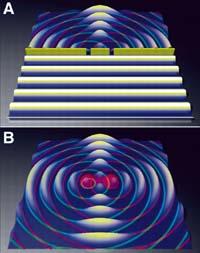From the quantum world to the macroscopic world

International research repeats Thomas Young's experiment on a hydrogen molecule. The results of the research have been published in the latest issue of the journal Science and researchers say they can serve to understand the transition between classical physics and quantum.
Thomas Young conducted in 1803 an experiment that served to develop the theory of the wave motion of light. He saw that the light of a remote spring, after passing through two networks, changed direction and formed a pattern of interference. Now researchers have repeated this experiment, but using electrons instead of light, and hydrogen protons instead of emission grids.
Two electrons are released from the hydrogen molecule and, in the journey to the detector that receives them, each electron has an interference pattern similar to that of a wave and not that of the particle. The interference pattern of each electron depends on the presence and speed of the other electron extracted from the molecule. Precisely, the analysis of velocity patterns allows to analyze the transition mechanisms between classical and quantum physics, as pointed out by the vice-rector of the Center for Materials Physics, Ricardo Díez (CSIC-UPV) and one of the authors of the article.
Buletina
Bidali zure helbide elektronikoa eta jaso asteroko buletina zure sarrera-ontzian











